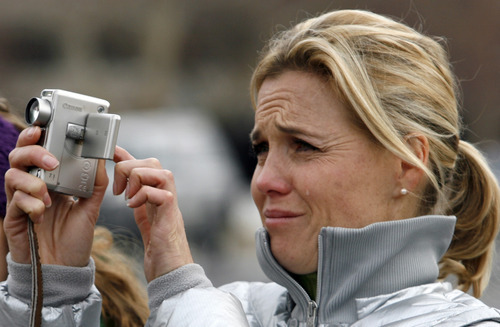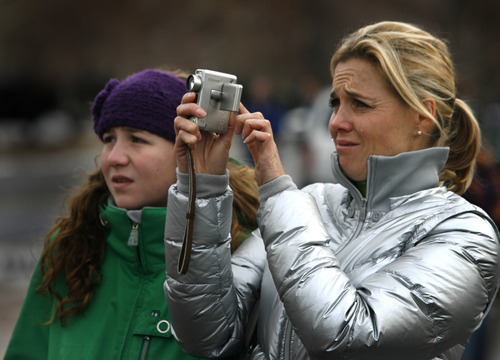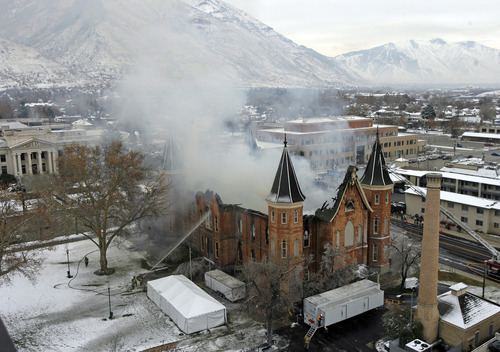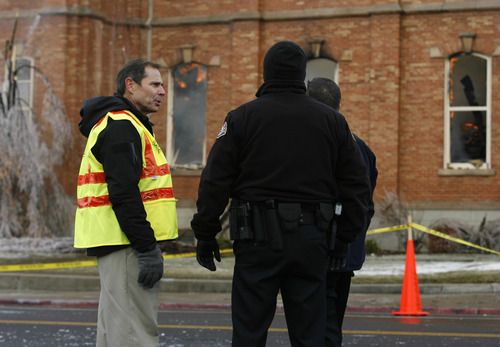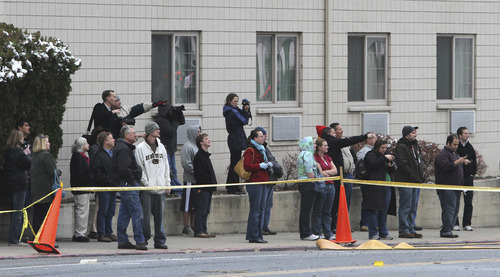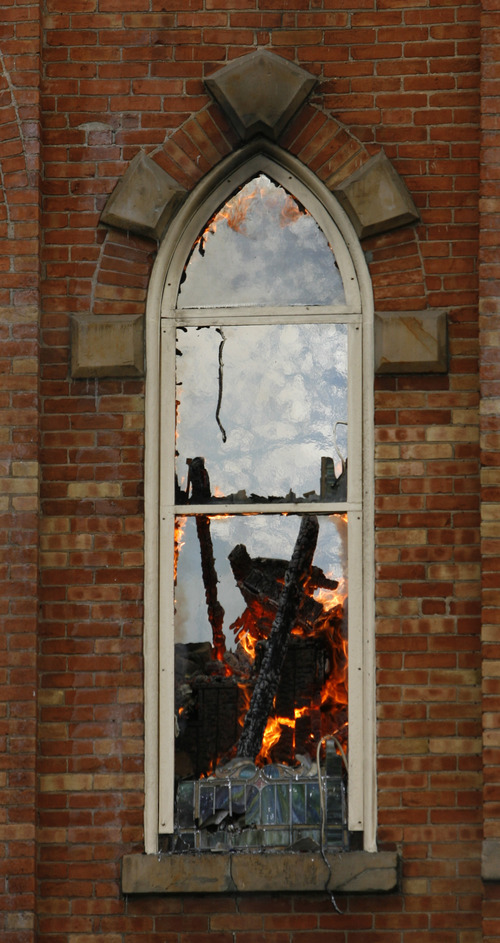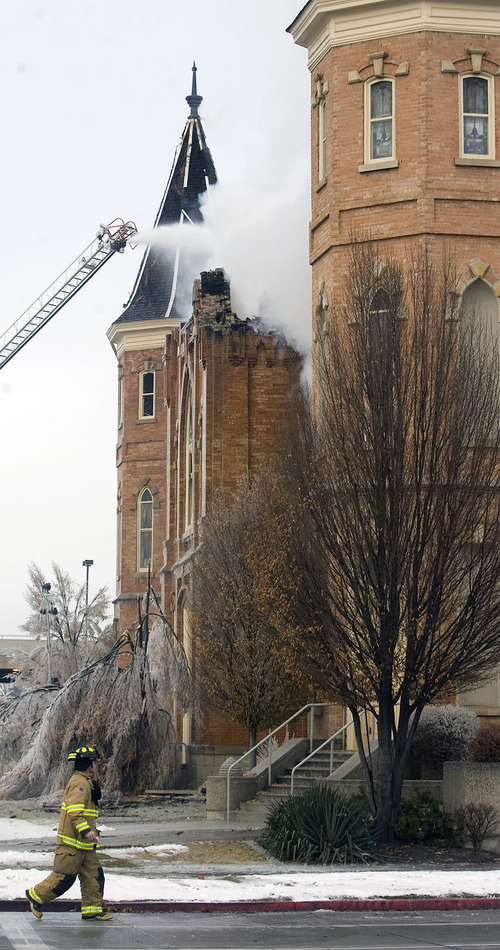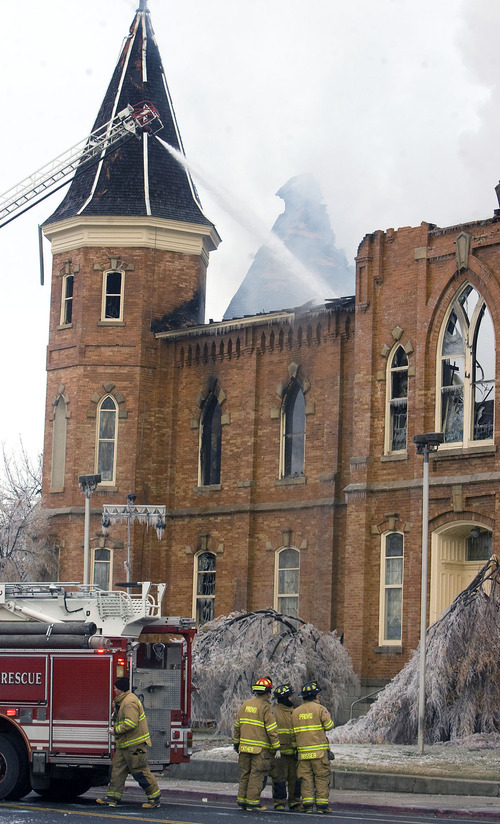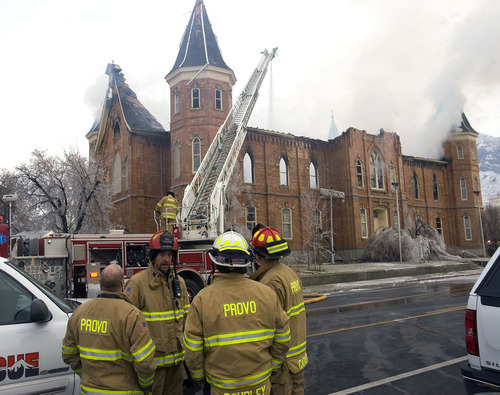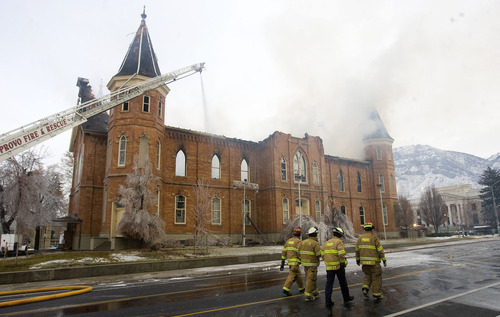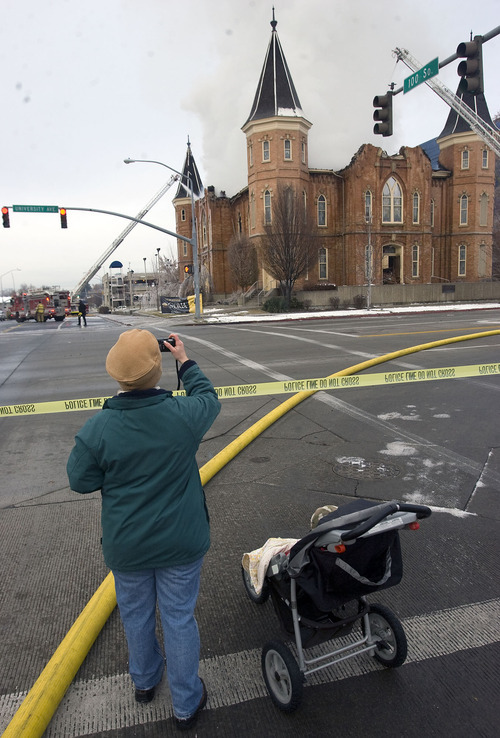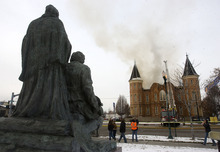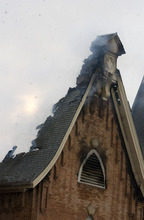This is an archived article that was published on sltrib.com in 2010, and information in the article may be outdated. It is provided only for personal research purposes and may not be reprinted.
Provo • The venerable Provo Tabernacle hosted everyone from U.S. presidents to a Russian composer to myriad rosy-cheeked children in its long history at the heart of Provo's cultural life.
On Friday, fire burned a hole in that heart, leaving the iconic building a blackened ruin, and many community members mourning its possible demise.
"I started crying, and I still am," said Jennie Vaughn, who came from Orem on Friday morning when she heard the LDS Church-owned tabernacle was on fire. "I think about the history [of the building], why it was built, the people who built it and the sacrifices they made."
The four-alarm fire, which was reported at 2:43 a.m., burned so fiercely through the twisting ornate hallways, wooden pews and heavy timber that Provo Fire Marshal Lynn Schofield pulled his crews out of the building.
About 25 firefighters poured water on the flames from outside throughout the early morning. The roof began collapsing around 5 a.m., and fell in completely an hour later, pulling down part of the front parapet and wall. Water from the firehoses glazed nearby trees in ice.
By mid-afternoon, crews were still dousing hot spots, encouraged that the walls were still standing.
Deputy Chief Gary Jolley said the cause of the fire still is unknown. An investigation will begin as soon as it is safe to enter what remains of the building. The fire department plans to provide an update on the fire Saturday afternoon.
While the smoke billowed, a crowd gathered, shooting photos and video and sharing memories. Among them was D. Robert Carter, a historian from Springville who first visited the tabernacle in the 1940s to sing in a Primary choir during an LDS stake conference.
"There won't be any more memories that happen there, is what saddens you," said Carter, who graduated with his Provo High School class at the tabernacle in 1957 and attended cultural events there as an adult.
On Thursday night, Lex de Azevedo, director of the 200-voice Millennium Choir, left the building at about 11 p.m. after a full day of rehearsals of de Azevedo's dramatic musical composition "Gloria." He was shocked and heartbroken by news of the fire.
The fire destroyed the "exquisite" Fazioli piano that de Azevedo had rented. Harpist Emily Zurcher, a Utah native transplanted to Los Angeles who returns annually to play in the concert, lost the Lyon & Healy concert grand harp she had borrowed from the family of a former student. She estimated its value at more than $20,000.
"It's horrible," Zurcher said of the owners' reaction. "It's really hard for them."
Timpani player Ron Brough told de Azevedo he wouldn't be able to replace his sticks, which he had collected over a lifetime.
"I can't even think about the fallout of all of this, the liability," de Azevedo said. "Nobody has had a chance to address that."
But he was grateful no one was injured.
A spokesman for The Church of Jesus Christ of Latter-day Saints said it's too soon to know whether the building can be saved. If the tabernacle must be demolished, Provo will lose not only a community gathering place but a piece of Utah's history, said Scott Trotter.
The tabernacle, he said, was "a reminder of the pioneering spirit that built Utah," Trotter said.
And that's why many Utahns will feel the pain of this tragedy, said Kirk Huffaker, executive director of the Utah Heritage Foundation, a nonprofit that advocates for historical preservation.
He called the tabernacle, which is listed on the U.S. National Register of Historic Places, "one of the most important buildings in the state in terms of history and architecture … It was built at a time when the LDS Church was still constructing buildings that took enormous dedication on behalf of its members."
The building's architect was William Folsom, designer of a number of Utah's LDS tabernacles and temples. He patterned it after the Salt Lake Assembly Hall on Temple Square, although the Provo Tabernacle is bigger and has four large octagonal staircase towers, one at each corner of the building.
It became the city's cultural heart even before it was finished, a process that took 13 years, according to Carter.
Two years after construction began in 1883 to replace a smaller tabernacle to the north, 2,000 people attended a memorial service there for U.S. President Ulysses S. Grant. "There were temporary seats, no windows, no doors and no permanent floor," Carter said.
It's perplexing, now, he said, to consider that event, given the acrimony that then prevailed between the federal government and Mormon pioneers.
One of Carter's favorite stories concerns the visit of early-20th-century Russian composer and pianist Sergei Rachmaninoff, who performed in the tabernacle during an era when BYU brought a series of prominent musicians to the city.
The Orem Electric Railroad ran next to the tabernacle and the depot was just to the west.
"Right in the middle of his performance, it went through with bells clanging," said Carter. Some in the audience remembered Rachmaninoff suspending his hands above the keys; others recalled his hands resting in his lap. In any case, once the train passed, the concert resumed, Carter said.
"I'm sure there have been hundreds, even thousands of unusual things like that."
More common, though, were the thousands of everyday gatherings that filled the tabernacle with song, applause and prayer.
Provo resident Brent Troutner said his mother's graduation ceremony took place in the tabernacle in the 1950s. The building was also where he attended concerts, plays and church conferences.
"I feel a little better with seeing the walls [still standing]," Troutner said as he watched smoke waft from the still-smoldering shell.
But it hasn't been just a gathering spot for Mormons.
"It was not only a beautiful, historic building, but a place where we were all part of a greater community," said a written statement from Provo Seventh-day Adventist Church Pastor Carlos Garcia and head elder Brad E. Walton. They offered their own church building and community center for events that have been displaced by the fire.
Kena Jo Mathews, chairwoman of the Utah Valley Ministerial Association, called the tabernacle "the heart and soul of our community." In a written statement, she said the building "provided many opportunities for people of varying faiths to come together in celebration of religious freedom and love."
Amid the destruction, there may be a bright spot.
While an original 1934 painting by noted Utah artist Minerva Teichert that hung below the gallery was lost in the fire, Provo police Officer Rory Rasmussen said a gold-framed picture of Jesus Christ was found intact in the tabernacle's east entrance.
"That should give people some solace," said Provo Municipal Councilwoman Cynthia Dayton after seeing Rasmussen's photograph of the portrait in the rubble.
Tribune staffer Ellen Fagg Weist contributed to this report —
Provo Tabernacle historical highlights
1883 • Construction begins
1885 • Memorial service for U.S. President Ulysses S. Grant
1886-87 • LDS General Conference
1898 • Building completed at a cost of $100,000
1909 • Speech by U.S. President William Howard Taft
1917-18 • First renovation due to roofing flaws
1949 • Second renovation due to roof sagging
1980s • Major renovation restores roof, interior elements
Sources • LDS.org, http://www.waymarking.com, D. Robert Carter, Provo Public Library, http://www.provotabernacle.org "I think it has been the heart of our city. So many people go through experiences in the city there … I'm holding out hope that there will be another Christmas miracle, and we will be able to restore the building to what it was."
Provo Municipal Councilwoman Sherrie Hall Everett
"It is a part of the community. Presidents of the United States have spoken there."
D. Robert Carter, historian
"If it were only a beautiful, historic old structure. It's much, much more than that. It's part of the pioneering story, to say the least."
Provo resident Russell Bateman, who has performed with choirs in the Tabernacle
"The Provo Tabernacle was about more than mere bricks and mortar; it was an enduring symbol of the city and of the faith and fortitude of those early Utah pioneers. Fire may have destroyed the building, but it will never tarnish their proud legacy."
U.S. Sen. Orrin G. Hatch, R-Utah
"I'm heartbroken. This is something the whole community is going to mourn. It is a big loss."
Provo Mayor John Curtis
"I learned an interesting thing from all this. All material things, they all end up as dust. But you can't kill music. It gets recreated, every time we perform it, for a moment."
Composer Lex de Azevedo


